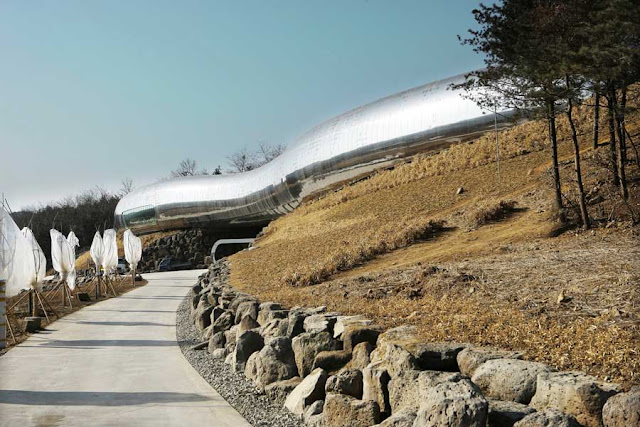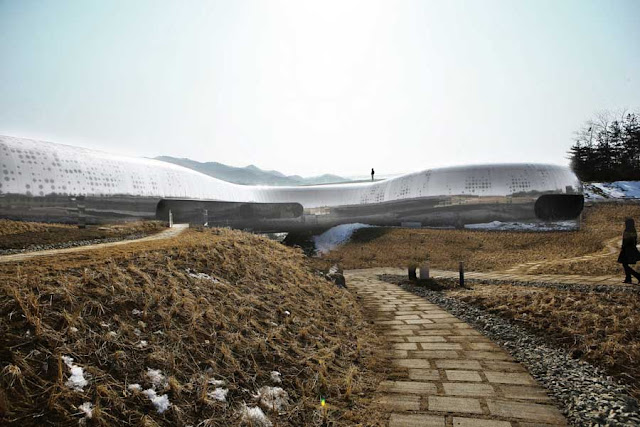Architect: X-TU
On the river side, in a winding landscape, a bridge
stretched between two cliffs, a threshold, a bridge
spanning a precipice …
We wished to honour the riverside landscape which saw the birth of the first inhabitants of Korea, and acknowledge the beauty of the two hill curves echoing the river meanders.
How to enhance such a pre-existent form and its geological underground chasm ?
- by digging the chasm to let the Earth tell its history
- by alleviating the visual hold of the project in order to let the chasm express itself ;
- for this purpose, the building will be enchased into the hill which has been hollowed out and the stockrooms wil be located underground ;
- by curving the central part of the building so as to unveil the geological crack (and also the sun, from the edge of the crack) ;
- by clothing it in a « shimmering skin » which will reflect the precipice from underneath.
Thus set up, the project appears like a bridge stretched between two cliffs which can be seen from a long distance from the motorway.
The precipice as a natural threshold and the emotion it induces, will be used to realize a symbolic threshold into the "prehistoric era" which will also give access to the "prehistory park" ;
Then we create paths, many paths around the curves of the project and of the cliffs, because the paths which were made by the animals going down to the river to drink, belonged to the « first human beings » landscape.
An immaterial-abstract-shaped « time vessel » :
We want to travel through history !
We wished the visitors to live an experience, to meet primitive mankind and to be introduced into a world different from everyday life, nearer the landscape than the building.
Paleolithic men were not living like us in standardized built places. They kept moving in the landscape, the forests, the stream valleys, the delta marshes of which they knew every meander. The rocks and the bare ground were their everyday life, as familiar to them as the house floor to us.
Such a physical and intellectual experience has its own course but it also breaks with the usual form referents and resorts to abstract and immaterial forms to :
- let the site geography speak
- let the museographic arrangements inside speak
Outside, it is a threshold, a bridge that spans the precipice. Inside, the project seems entirely made out of the same material, an archaic and primitive material, as if it had been shaped out of the cliff itself.
One with the abyss and with a shimmering envelope
A double metal envelope with various perforations, waving and soft, nearly organic, the front shimmers like a reptile skin ; more or less glazed according to different places, changing with the light, it becomes a stainless steel mirror underneath which reflects the image of the chasm.
The museum, a threshold to the Prehistory park
From the motorway, the museum looks like a strange and immaterial volume, softly glimmering, stretched between two cliffs. Around it the landscape has been restored, cleared of its undesirable buildings, and given back its original identity as a natural riverside site.
The parking places disappear under the trees on the eastern side of the place. With its new trees the site recovers its primitive ecosystem.
A walk along the rift gets the visitor into condition. Like the primitive men, he progresses along the meander, amid wild graminaceae.
The rift deepens along with the feeling of suspense as he is coming nearer…The museum appears, enchased in the cliff. Then on its stain-steel mirror underface, the reflection of the chasm is suddenly unveiled, and at last the chasm itself is revealed and the visitor will have to cross over on a foot-bridge.
Having crossed the chasm, he reaches the only entrance to the museum and the Prehistory Park. In the museum , a circular way which extends into the Prehistory Park :
On top of the stairs, an open space gives access to the reception, the entrance to the museum and the exhibition, the cafeteria, the lecture-room, the pedagogic activities and the multimedia laboratory.
The visitor walks all around the factual parts of the project : temporary exhibitions and lecture-room. Back at the open space he can go again to the shop or the museum…
The pedagogic and multimedia activities can be seen from outside, as the rooms are open, so that the visitor is encouraged to take part.
Rooms and halls are conceived like landscapes : Primitive men were not living in « rooms » but in open spaces. Living near the river they roamed freely along the country meanders. Their roaming made the paths which gave the site a structure.
The inside of the museum and its scenographic course have been conceived after that image, like a landscape.
The paths from theme to theme made by the flow of visitors meet, part freely and allow to go back.
An envelope for services clears the space :
The walls of various thickness contain all the services needed for the building and the museum : structure, fluids, ventilation, electricity, audio and lighting equipment, as well as show windows for the museum, pedagogic stocks, bar, lavatories, technical rooms.
The walls are uninterrupted from floor to ceiling, so that the network can evolve, when necessary all around the building.
Light and view on the landscape :
The envelope filters the light like a lattice. The double wall includes glazings and solar protections in perforated metal and makes it possible to have a perfect command of heat exchange of the building, in winter as in summer. The admission of natural light is adjustable according to the needs of scenographic effects.
On the level of the cafeteria and the central space, panoramic windows open on the landscape.
The scenography
Our purpose :
- allow the visitor to share the emotion of the paleontologist who discovers the prints of a child’s naked feet on the soft soil of a cave ;
- a scenography able to evolve with the progress of research.
The project offers evolutive scenographic tools to be combined :
- the « image walls » for texts, plans, drawings and movie showing.
- The « service walls » which will contain new show windows as research progresses
- Malleable recomposable white mud floor to reconstruct archeological sites and feel the emotion of the site inventor.
- the « service columns » to make up the landscape and evolve from area to area or from era to era. According to their position, they bring light, support projection or fitting equipment.
They are freely organized in « archipelagos » which constitute thematic micro-spaces.
- Electricity and audio work-nets are regularly dis tributed in the ceilings. The sequences :
- the presentation about the paleolithic era in Jeongok site.
- the human evolution during the prehistoric era : the various ages progress in the archipelago of the service columns.
- The large arrangement reconstructing an archeological excavation site : it can be seen from the entrance and it is meant to attract visitors but it is not wholly discovered until the end of the visit.
The common scenographic spaces
- The interactive multimedia space is free of access and common to the temporary exhibition and the museum.
- the “Chasm doms”, transparent port-holes directed toward the void make it possible to see the pit.
- The balcony over the pit where we come within an ace of the abyss before leaving towards the out side museographic space and the view-point on top of the hill (prehistory park).
This outside walk in the prehistory park is shaped as a circular path which leads back to the central reception space.
The pedagogic workrooms and the multimedia lab :
The workroom is equipped like the museographic hall with malleable mud floor for the teaching of archeological methods , with walls meant for projections and walls meant for paleolithic rock painting, and on the floor are scattered boulders on which to sit when working flint.
The multimedia lab is arranged as an extension of the cafeteria as it can be used either as a group activity or an archeological Internet café.
The inside functions of the museum and the deliveries :
The administration and research office and the staff restroom are located along the exhibition spaces, near at hand for the setting of new exhibitions. Stock-rooms for non exhibited collections and the maintenance rooms are located under the showroom, and served by a goods-lift from the upstairs level of “the prehistory park”.
So, the organization of the building takes advantage of the double access made possible by the location on a slope: visitors in the lower part and deliveries on top of the cliff, out of the opening hours.
Jeongok Prehistory Museum - Building Information
Architects + Museography: X-TU
Nicola DESMAZIERE + Anouk LEGENDRE
Team: Gaelle Leborgne, Olivier Busson, Mathias Lukacs, Keeyong Lee, Amelie Busin, Alix Pellen, Seung-Eun Lee, Mélanie Bury, Nenad Basic
Client: Gyeonggi governement
Situation: city of Jeongok region of Gyeonggi-do South Korea
Program: cultural / museum of prehistory
Planning
competition Apr 2006
contract: May 2007
building: Jun 2008
completion: May 2011
Total floor area: 6 700 m² shon
Total site area: 72.600 m²
Cost: 48 m equivalent € [building + museography + landscape]
Engineering consortium:
SAC int.: architects/ing
Séoul Sous-traitants:
RFR: engineering structur, façads
Alto ingenierie: engineering fluids
8’18’’: lighting
OGI: bet vrd
Lord Cultur: muséographic consultant
F. Demeter: scientific consultant
Company: Hyundai
Jeongok Prehistory Museum images / information from X-TU
http://www.e-architect.co.uk/korea/jeongok_prehistory_museum.htm














Δεν υπάρχουν σχόλια:
Δημοσίευση σχολίου